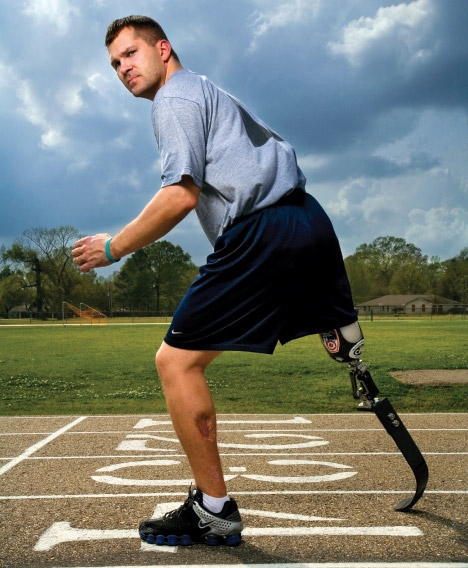Run Run Michael
Bionic limbs give wounded soldiers a leg up.
Not long ago, prosthetic limbs had all of the function and mobility of a peg leg from a pirate movie. But in this bionic age, wood and plastic are no longer acceptable replacements for nerve, bone, and muscle. When Sgt. 1st Class Michael McNaughton (left) lost his leg to a land mine in Afghanistan in 2003, he got more than a rigid limb that would simply hold him upright. He got a leg with brains.
Throughout history, wars have spurred advances in medicine, and current conflicts are no exception. The hundreds of soldiers who have lost limbs in Iraq and Afghanistan have inspired a revolution in prosthetic design. Perhaps the most important innovations have been the C-Leg and the newer Rheo Knee, bionic limbs that have become standard equipment for soldiers missing legs. The limbs have microprocessors that constantly sense force and the direction of the user’s gait. The tiny computers then send a signal to hydraulic shafts that let the knee flex as naturally as possible.
For McNaughton — one of the first soldiers to get a C-Leg and one of the first to move up to the stronger, more durable Rheo Knee — the circuitry in the legs provides freedom to think about something other than taking the next step. “I can go down stairs holding my baby girl without worrying about it,” McNaughton says. He can also run, play soccer, and even get in a few basketball games.
Despite these advances, the field of prosthetic engineering is still in its relative infancy, says Gerald Loeb, a professor of biomedical engineering at the University of Southern California. Lifelike hands, he says, are the next big challenge. Scientists have already created hands that can pick up grapes and other small objects. The trick now, he says, is to develop sensors that can precisely move fingers according to a person’s thoughts. “The brain uses a complex code that we’re still trying to understand,” Loeb says. “It’s not just engineering — it’s discovering.”
Amputees of all types can benefit from cutting-edge prosthetics, but soldiers tend to make ideal patients, Loeb says. Unlike people who have lost limbs to cancer or diabetes, soldiers tend to be young, relatively healthy, and able to push themselves to get the most out of rehabilitation. “Being a soldier is their career, and they often want to get back to it,” he says.
McNaughton — who received his leg free of charge from Walter Reed Medical Hospital — now works for the Veterans Administration in his home state of Louisiana. He says he doesn’t mind stares when he walks through Wal-Mart. “I have three kids, and they think it’s really cool,” he says.
Watch this video on the Rheo knee, a bionic knee:
Filed under: Biomedical, Materials
Tags: Biomedical, Bioscience, Biotechnology, Materials, Technology









